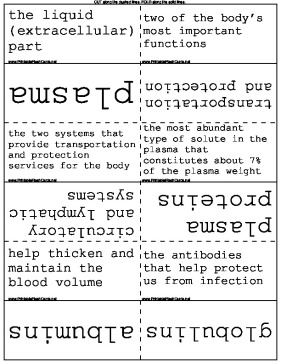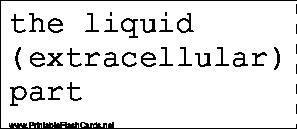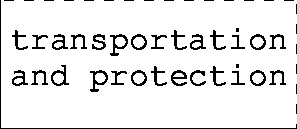

Learn about the circulation of blood in the human body in these anatomy flash cards.
There are 60 flash cards in this set (10 pages to print.)
To use:
1. Print out the cards.
2. Cut along the dashed lines.
3. Fold along the solid lines.
Sample flash cards in this set:




| Questions | Answers |
|---|---|
| the liquid (extracellular) part | plasma |
| two of the body's most important functions | transportation and protection |
| the two systems that provide transportation and protection services for the body | circulatory and lymphatic systems |
| the most abundant type of solute in the plasma that constitutes about 7% of the plasma weight | plasma proteins |
| help thicken and maintain the blood volume | albumins |
| the antibodies that help protect us from infection | globulins |
| two proteins that are necessary for blood clotting | fibrinogen and prothrombin |
| plasma minus its clotting factors | blood serum |
| as a general rule how many liters of blood does an adult have? | 4 to 6 liters |
| Blood accounts for how much of the total body weight | 7% to 9% |
| three main types of formed elements | erythrocytes (RBCs) leukocytes (WBCs) thrombocytes (platelets) |
| have granules in their cytoplasm | Granular leukocytes |
| three subdivisions of granular leukocytes | neutrophils eosinophils basophils |
| do not have granules in their cytoplasm | nongranular leukocytes |
| two subdivisions of nongranular leukocytes | lymphocytes monocytes |
| two kinds of connective tissue that makes blood cells for the body | myeloid tissue lymphatic tissue |
| formation of new blood cells | hematopoiesis |
| another name for myeloid tissue | red bone marrow |
| A cell that is "caved in" on both sides so that each one has a thin center and thicker edges. They have no nucleus | RBCs |
| One essential function of RBCs | help transport carbon dioxide |
| red pigment | hemoglobin |
| hemoglobin in RBCs unite with oxygen to form | oxyhemoglobin |
| Hemoglobin can also carry a small proportion of the CO2 carried by the blood forming | carbaminohemoglobim |
| a condition caused by an inability of the blood to carry sufficient oxygen to the body cells | anemia |
| a result from a decrease in the number of RBCs caused by hemorrhage | hemorrhagic anemia |
| a reduction in RBC numbers following destruction of the blood-forming elements in bone marrow | aplastic anemia |
| a deficiency of RBCs that results from a failure of the stomach lining to produce the substance that allows vitamin B12 to be absorbed from the food we eat | pernicious anemia |
| a hereditary disease caused by an abnormal type of hemoglobin that is severe or sometimes fatal | sickle cell anemia |
| results when the is inadequate iron in the diet | iron deficiency anemia |
| bone marrow produces an excess of RBCs | polysythemi |
| a measure of the total blood volume made up by the RBCs | hematocrit (Hct) |
| as a blood sample is spun down, the WBCs and platelets settle out in a layer called | buffy coat |
| caused by excessive loss of body water | dehydration |
| that total number of WBCs per cubic millimeter (mm3) of whole blood ranges between 5,000 and 9,000 | total WBC count |
| the proportions of each type of WBC are reported as percentages of the total WBC count. | differential WBC count |
| an abnormally low WBC count (less than 5,000 WBC/mm3 of blood) | leukopenia |
| an abnormally high WBC count (more than 10,000 WBCs/mm3) | leukocytosis |
| the most numerous of the active WBCs (phagocytes-protecting the body from invading microorganisms) | neutrophils |
| weak phagocytes, provides protection against infections caused by parasitic worms. | Eosinophils |
| found in peripheral blood they secret the chemical histamine, which is released during the inflammatory reaction | basophils |
| the largest leukocytes and are aggressive phagocytes | monocytes |
| specialized monocytes that grow to several times their original size after migrating out of the bloodstream. | macrophages |
| help protect us against infections, but they do it by a process different from phagocytosis | Lymphocytes |
| a term used to describe a number of blood cancers affecting the WBCs | leukemia |
| damaged tissue cells in an injured vessel wall release certain clotting factors into the plasma these factors rapidly react with other factors already present in the plasma to form | prothrombin activator |
| a soft temporary plug that accumulates near the opening in a broken blood vessel. | platelet plug |
| the next step of clotting by converting prothrombin to | thrombin |
| in the last step of clotting thrombin reacts with this to change it to a fibrous gel called fibrin | fibrinogen |
| a clot stays in the place where it was formed | thrombus |
| the condition when a clot stays in the place where it was formed | thrombosis |
| if part of the clot dislodges and circulates through the bloodstream, the dislodged part is called | embolus |
| the condition of a part of a clot dislodges and circulating in the bloodstream | embolism |
| a substance that can activate the immune system to make certain responses, including the production of antibodies | antigen |
| a substance made by the body in response to stimulation by an antigen | antibody |
| the process of many antibodies reacting with their antigens | agglutinate |
| testing for the presence or absence of an additional antigen | Rh antigen |
| Rh antigen is the basis for classifying ______ | Rh-positive or Rh-negative |
| universal donor blood universal recipient blood | O- AB+ |
| caused by a mother's Rh antibodies reacting with the baby's Rh-positive cells. | erythroblastosis fetalis |
| carefully matched blood to the blood of the recipient for ABO and Rh compatibility and also tested further | crossmatching |